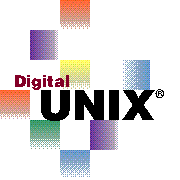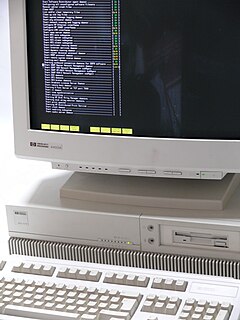Related Research Articles

Alpha is a 64-bit reduced instruction set computer (RISC) instruction set architecture (ISA) developed by Digital Equipment Corporation (DEC). Alpha was designed to replace 32-bit VAX complex instruction set computers (CISC) and to be a highly competitive RISC processor for Unix workstations and similar markets.

VAX is a series of computers featuring a 32-bit instruction set architecture (ISA) and virtual memory that was developed and sold by Digital Equipment Corporation (DEC) in the late 20th century. The VAX-11/780, introduced October 25, 1977, was the first of a range of popular and influential computers implementing the VAX ISA. The VAX family was a huge success for DEC – over 100 models were introduced over the lifetime of the design, with the last members arriving in the early 1990s. The VAX was succeeded by the DEC Alpha, which included several features from VAX machines to make porting from the VAX easier.

Tru64 UNIX is a discontinued 64-bit UNIX operating system for the Alpha instruction set architecture (ISA), currently owned by Hewlett-Packard (HP). Previously, Tru64 UNIX was a product of Compaq, and before that, Digital Equipment Corporation (DEC), where it was known as Digital UNIX.

Ultrix is the brand name of Digital Equipment Corporation's (DEC) discontinued native Unix operating systems for the PDP-11, VAX, MicroVAX and DECstations.
This article presents a timeline of events in the history of computer operating systems from 1951 to the current day. For a narrative explaining the overall developments, see the History of operating systems.
OSF/1 is a variant of the Unix operating system developed by the Open Software Foundation during the late 1980s and early 1990s. OSF/1 is one of the first operating systems to have used the Mach kernel developed at Carnegie Mellon University, and is probably best known as the native Unix operating system for DEC Alpha architecture systems.

Seventh Edition Unix, also called Version 7 Unix, Version 7 or just V7, was an important early release of the Unix operating system. V7, released in 1979, was the last Bell Laboratories release to see widespread distribution before the commercialization of Unix by AT&T Corporation in the early 1980s. V7 was originally developed for Digital Equipment Corporation's PDP-11 minicomputers and was later ported to other platforms.

PRISM was a 32-bit RISC instruction set architecture (ISA) developed by Digital Equipment Corporation (DEC). It was the outcome of a number of DEC research projects from the 1982–1985 time-frame, and the project was subject to continually changing requirements and planned uses that delayed its introduction. This process eventually decided to use the design for a new line of Unix workstations. The arithmetic logic unit (ALU) of the microPrism version had completed design in April 1988 and samples were fabricated, but the design of other components like the floating point unit (FPU) and memory management unit (MMU) were still not complete in the summer when DEC management decided to cancel the project in favor of MIPS-based systems. An operating system codenamed MICA was developed for the PRISM architecture, which would have served as a replacement for both VAX/VMS and ULTRIX on PRISM.

The DECstation was a brand of computers used by DEC, and refers to three distinct lines of computer systems—the first released in 1978 as a word processing system, and the latter two both released in 1989. These comprised a range of computer workstations based on the MIPS architecture and a range of PC compatibles. The MIPS-based workstations ran ULTRIX, a DEC-proprietary version of UNIX, and early releases of OSF/1.

Unix System V is one of the first commercial versions of the Unix operating system. It was originally developed by AT&T and first released in 1983. Four major versions of System V were released, numbered 1, 2, 3, and 4. System V Release 4 (SVR4) was commercially the most successful version, being the result of an effort, marketed as Unix System Unification, which solicited the collaboration of the major Unix vendors. It was the source of several common commercial Unix features. System V is sometimes abbreviated to SysV.
The Advanced Computing Environment (ACE) was defined by an industry consortium in the early 1990s to be the next generation commodity computing platform, the successor to personal computers based on Intel's 32-bit instruction set architecture. The effort found little support in the market and dissolved due to infighting within the group and a lack of sales.
AT&T Computer Systems is the generic name for American Telephone & Telegraph's unsuccessful attempt to compete in the computer business. In return for divesting the local Bell Operating Companies, AT&T was allowed to have an unregulated division to sell computer hardware and software. The company made the 3B series computers.
RISC/os is a discontinued UNIX operating system developed by MIPS Computer Systems, Inc. from 1985 to 1992, for their computer workstations and servers, including such models as the MIPS M/120 server and MIPS Magnum workstation. It was also known as UMIPS or MIPS OS.

In computer programming, Franz Lisp is a discontinued Lisp programming language system written at the University of California, Berkeley by Professor Richard Fateman and several students, based largely on Maclisp and distributed with the Berkeley Software Distribution (BSD) for the Digital Equipment Corporation (DEC) VAX minicomputer. Piggybacking on the popularity of the BSD package, Franz Lisp was probably the most widely distributed and used Lisp system of the 1970s and 1980s.
DECsystem was a line of server computers from Digital Equipment Corporation. They were based on MIPS architecture processors and ran DEC's version of the UNIX operating system, called ULTRIX. They ranged in size from workstation-style desktop enclosures to large pedestal cabinets.

The Sony NEWS is a series of Unix workstations sold during the late 1980s and 1990s. The first NEWS machine was the NWS-800, which originally appeared in Japan in January 1987 and was conceived as a desktop replacement for the VAX series of minicomputers.
The Firefly was a shared memory asymmetric multiprocessor workstation, developed by the Systems Research Center, a research organization within Digital Equipment Corporation. The first version built contained up to seven MicroVAX 78032 microprocessors. The cache from each of the microprocessors kept a consistent view of the same main memory using a cache coherency algorithm, the Firefly protocol. The second version of the Firefly used faster CVAX 78034 microprocessors. It was later introduced as a product by DEC as VAX-3520/3540 and called 'Firefox'.

The Berkeley Software Distribution or Berkeley Standard Distribution (BSD) is a discontinued operating system based on Research Unix, developed and distributed by the Computer Systems Research Group (CSRG) at the University of California, Berkeley. The term "BSD" commonly refers to its descendants, including FreeBSD, OpenBSD, NetBSD, and DragonFly BSD.
The History of the Berkeley Software Distribution begins in the 1970s.
MICA was the codename of the operating system developed for the DEC PRISM architecture. MICA was designed by a team at Digital Equipment Corporation led by Dave Cutler. MICA's design was driven by Digital's need to provide a migration path to PRISM for Digital's VAX/VMS customers, as well as allowing PRISM systems to compete in the increasingly important Unix market. MICA attempted to address these requirements by implementing VMS and ULTRIX user interfaces on top of a common kernel that could support the system calls, libraries and utilities needed for both environments.
References
- ↑ Ceruzzi, Paul E. (2003). A history of modern computing . MIT Press. p. 336. ISBN 978-0-262-53203-7.
- ↑ "The History of the UNIX® License Plate". The Open Group. Retrieved July 7, 2013.
- ↑ Salus, Peter H. (1995). Casting the Net - From the ARPAnet to the Internet and beyond. Addison-Wesley. p. 135. ISBN 978-0-201-87674-1.
- ↑ Salus, Peter H. (1994). A quarter century of UNIX. Addison-Wesley. p. 218. ISBN 978-0-201-54777-1.
- ↑ "DECconnection Newsbytes" (PDF). March 2011. p. 3. Retrieved July 7, 2013.
- ↑ "Armando Stettner: Vice President, Engineering in the Office of the CTO". Gigabit Squared. Archived from the original on 5 November 2013. Retrieved July 7, 2013.
- ↑ "An Open Letter From Security Experts, Academics and Engineers to the U.S. Congress: Stop Bad Cybersecurity Bills". April 23, 2012. Retrieved July 7, 2013.